Solutions Manual
for
Digital Communications, 5th Edition
(Chapter 2) 1
Prepared by
Kostas Stamatiou
January 11, 2008
1PROPRIETARY MATERIAL. cThe McGraw-Hill Companies, Inc. All rights reserved. No part of this
Manual may be displayed, reproduced or distributed in any form or by any means, without the prior written
permission of the publisher, or used beyond the limited distribution to teachers and educators permitted by
McGraw-Hill for their individual course preparation. If you are a student using this Manual, you are using
it without permission.
�
Problem 2.1
a.
Hence :
2
da
x(a)
t − a
1
−∞
ˆx(t) =
πZ ∞
πR ∞
−ˆx(−t) = − 1
πR −∞
= − 1
πR ∞
= − 1
πR ∞
= 1
−∞
∞
−∞
−∞
x(a)
−t−a da
x(−b)
−t+b (−db)
x(b)
−t+b db
t−b db = ˆx(t)
x(b)
where we have made the change of variables : b = −a and used the relationship : x(b) = x(−b).
b. In exactly the same way as in part (a) we prove :
ˆx(t) = ˆx(−t)
c. x(t) = cos ω0t, so its Fourier transform is : X(f ) = 1
Exploiting the phase-shifting property (2-1-4) of the Hilbert transform :
2 [δ(f − f0) + δ(f + f0)] , f0 = 2πω0.
ˆX(f ) =
1
2
[−jδ(f − f0) + jδ(f + f0)] =
1
2j
[δ(f − f0) − δ(f + f0)] = F −1 {sin 2πf0t}
Hence, ˆx(t) = sin ω0t.
d. In a similar way to part (c) :
x(t) = sin ω0t ⇒ X(f ) =
1
2j
[δ(f − f0) − δ(f + f0)] ⇒ ˆX(f ) =
1
2
[−δ(f − f0) − δ(f + f0)]
⇒ ˆX(f ) = −
1
2
[δ(f − f0) + δ(f + f0)] = −F −1 {cos 2πω0t} ⇒ ˆx(t) = − cos ω0t
e. The positive frequency content of the new signal will be : (−j)(−j)X(f ) = −X(f ), f > 0, while
ˆˆX(f ) = −X(f ),
the negative frequency content will be : j · jX(f ) = −X(f ), f < 0. Hence, since
we have : ˆˆx(t) = −x(t).
f. Since the magnitude response of the Hilbert transformer is characterized by :
|H(f )| = 1, we
have that : ˆX(f ) = |H(f )||X(f )| = |X(f )| . Hence :
df =Z ∞
−∞
2
Z ∞
−∞ ˆX(f )
|X(f )|2 df
PROPRIETARY MATERIAL. cThe McGraw-Hill Companies, Inc. All rights reserved. No part of this Manual may be displayed,
reproduced or distributed in any form or by any means, without the prior written permission of the publisher, or used beyond the
limited distribution to teachers and educators permitted by McGraw-Hill for their individual course preparation. If you are a
student using this Manual, you are using it without permission.
�
and using Parseval’s relationship :
Z ∞
−∞
ˆx2(t)dt =Z ∞
−∞
x2(t)dt
3
g. From parts (a) and (b) above, we note that if x(t) is even, ˆx(t) is odd and vice-versa. Therefore,
x(t)ˆx(t) is always odd and hence : R ∞
−∞
x(t)ˆx(t)dt = 0.
Problem 2.2
1. Using relations
X(f ) =
Y (f ) =
1
2
1
2
Xl(f − f0) +
Yl(f − f0) +
1
Xl(−f − f0)
2
1
Yl(−f − f0)
2
and Parseval’s relation, we have
Yl(f − f0) +
1
2
Yl(−f − f0)∗
df
Xl(−f − f0)Yl(−f − f0) df
Z ∞
−∞
=
−∞
x(t)y(t) dt =Z ∞
−∞ 1
=Z ∞
4Z ∞
4Z ∞
ReZ ∞
ReZ ∞
1
2
1
2
−∞
−∞
=
=
1
1
=
X(f )Y ∗(f ) dt
1
2
Xl(−f − f0) 1
4Z ∞
Xl(f − f0) +
2
Xl(f − f0)Y ∗l (f − f0) df +
Xl(u)Y ∗l (u) du +
−∞
X∗l (v)Y (v) dv
2
1
1
4
Xl(f )Y ∗l (f ) df
xl(t)y∗l (t) dt
−∞
−∞
where we have used the fact that since Xl(f − f0) and Yl(−f − f0) do not overlap, Xl(f −
f0)Yl(−f − f0) = 0 and similarly Xl(−f − f0)Yl(f − f0) = 0.
2. Putting y(t) = x(t) we get the desired result from the result of part 1.
PROPRIETARY MATERIAL. cThe McGraw-Hill Companies, Inc. All rights reserved. No part of this Manual may be displayed,
reproduced or distributed in any form or by any means, without the prior written permission of the publisher, or used beyond the
limited distribution to teachers and educators permitted by McGraw-Hill for their individual course preparation. If you are a
student using this Manual, you are using it without permission.
�
n = 1, 2, ..., K
n = 1, 2, ..., K
−∞
s(t)f∗n(t)dt
Z ∞
s(t)f∗n(t)dt − sn = 0,
sn =Z ∞
k=1 skfk(t)ihs(t) −PK
−∞PK
−∞PK
k=1 skfk(t)s∗(t)dt
n=1 snfn(t)i∗ dt
n=1 s∗nR ∞
k=1 skfk(t)s∗(t)dt −PK
or:
−∞
The corresponding residual error Ee is :
Emin = R ∞
= R ∞
= R ∞
= Es −PK
−∞hs(t) −PK
−∞ |s(t)|2 dt −R ∞
−∞ |s(t)|2 dt −R ∞
k=1 |sk|2
−∞hs(t) −PK
k=1 skfk(t)i f∗n(t)dt
4
Problem 2.3
A well-known result in estimation theory based on the minimum mean-squared-error criterion states
that the minimum of Ee is obtained when the error is orthogonal to each of the functions in the
series expansion. Hence :
−∞"s(t) −
Z ∞
KXk=1
skfk(t)# f∗n(t)dt = 0,
n = 1, 2, ..., K
(1)
since the functions {fn(t)} are orthonormal, only the term with k = n will remain in the sum, so :
where we have exploited relationship (1) to go from the second to the third step in the above
calculation.
Note : Relationship (1) can also be obtained by simple differentiation of the residual error with
respect to the coefficients {sn} . Since sn is, in general, complex-valued sn = an + jbn we have to
differentiate with respect to both real and imaginary parts :
−∞hs(t) −PK
danR ∞
anfn(t)hs(t) −PK
Renf∗n(t)hs(t) −PK
−∞
d
−∞
danEe = d
⇒ −R ∞
⇒ −2anR ∞
⇒R ∞
−∞
Renf∗n(t)hs(t) −PK
n=1 snfn(t)io dt = 0,
n=1 snfn(t)i∗ dt = 0
k=1 skfk(t)ihs(t) −PK
n=1 snfn(t)i∗ + a∗nf∗n(t)hs(t) −PK
n=1 snfn(t)i dt = 0
n=1 snfn(t)io dt = 0
n = 1, 2, ..., K
PROPRIETARY MATERIAL. cThe McGraw-Hill Companies, Inc. All rights reserved. No part of this Manual may be displayed,
reproduced or distributed in any form or by any means, without the prior written permission of the publisher, or used beyond the
limited distribution to teachers and educators permitted by McGraw-Hill for their individual course preparation. If you are a
student using this Manual, you are using it without permission.
�
where we have exploited the identity : (x + x∗) = 2Re{x}. Differentiation of Ee with respect to bn
will give the corresponding relationship for the imaginary part; combining the two we get (1).
5
Problem 2.4
The procedure is very similar to the one for the real-valued signals described in the book (pages
33-37). The only difference is that the projections should conform to the complex-valued vector
space :
c12=Z ∞
−∞
s2(t)f∗1 (t)dt
and, in general for the k-th function :
cik =Z ∞
−∞
sk(t)f∗i (t)dt,
i = 1, 2, ..., k − 1
Problem 2.5
The first basis function is :
Then, for the second basis function :
c43 =Z ∞
−∞
Hence :
0,
g4(t) =
=
s4(t)
√3
s4(t)
√E4
=
−1/√3, 0 ≤ t ≤ 3
o.w.
s3(t)g4(t)dt = −1/√3 ⇒ g′3(t) = s3(t) − c43g4(t) =
1/√6,
0 ≤ t ≤ 2
−2/√6, 2 ≤ t ≤ 3
=
0 (g′3(t))2 dt = 8/3.
g′3(t)
√E3
g3(t) =
0,
o.w
0 ≤ t ≤ 2
2/3,
−4/3, 2 ≤ t ≤ 3
0,
o.w
where E3 denotes the energy of g′3(t) : E3 =R 3
For the third basis function :
c42 =Z ∞
−∞
s2(t)g4(t)dt = 0 and c32 =Z ∞
−∞
s2(t)g3(t)dt = 0
PROPRIETARY MATERIAL. cThe McGraw-Hill Companies, Inc. All rights reserved. No part of this Manual may be displayed,
reproduced or distributed in any form or by any means, without the prior written permission of the publisher, or used beyond the
limited distribution to teachers and educators permitted by McGraw-Hill for their individual course preparation. If you are a
student using this Manual, you are using it without permission.
�
Hence :
and
g2(t) =
g′2(t)
√E2
1/√2,
0 ≤ t ≤ 1
−1/√2, 1 ≤ t ≤ 2
0,
o.w
=
where : E2 =R 2
0 (s2(t))2 dt = 2.
Finally for the fourth basis function :
g′2(t) = s2(t) − c42g4(t) − c32g3(t) = s2(t)
6
c41 =Z ∞
−∞
s1(t)g4(t)dt = −2/√3, c31 =Z ∞
g′1(t) = s1(t) − c41g4(t) − c31g3(t) − c21g2(t) = 0 ⇒ g1(t) = 0
s1(t)g3(t)dt = 2/√6, c21 = 0
−∞
Hence :
The last result is expected, since the dimensionality of the vector space generated by these signals
is 3. Based on the basis functions (g2(t), g3(t), g4(t)) the basis representation of the signals is :
s4 =0, 0,√3 ⇒ E4 = 3
s3 =0,p8/3,−1/√3 ⇒ E3 = 3
s2 =√2, 0, 0 ⇒ E2 = 2
s1 =2/√6,−2/√3, 0 ⇒ E1 = 2
Problem 2.6
Consider the set of signalseφnl(t) = jφnl(t), 1 ≤ n ≤ N , then by definition of lowpass equivalent
signals and by Equations 2.2-49 and 2.2-54, we see that φn(t)’s are √2 times the lowpass equivalents
of φnl(t)’s and eφn(t)’s are √2 times the lowpass equivalents of eφnl(t)’s. We also note that since
φn(t)’s have unit energy, hφnl(t),eφnl(t)i = hφnl(t), jφnl(t)i = −j and since the inner product is pure
imaginary, we conclude that φn(t) and eφn(t) are orthogonal. Using the orthonormality of the set
φnl(t), we have
hφnl(t),−jφml(t)i = jδmn
and using the result of problem 2.2 we have
We also have
hφn(t),eφm(t)i = 0
for all n, m
hφn(t), φm(t)i = 0 for all n 6= m
PROPRIETARY MATERIAL. cThe McGraw-Hill Companies, Inc. All rights reserved. No part of this Manual may be displayed,
reproduced or distributed in any form or by any means, without the prior written permission of the publisher, or used beyond the
limited distribution to teachers and educators permitted by McGraw-Hill for their individual course preparation. If you are a
student using this Manual, you are using it without permission.
�
and
7
heφn(t),eφm(t)i = 0 for all n 6= m
Using the fact that the energy in lowpass equivalent signal is twice the energy in the bandpass
signal we conclude that the energy in φn(t)’s and eφn(t)’s is unity and hence the set of 2N signals
{φn(t),eφn(t)} constitute an orthonormal set. The fact that this orthonormal set is sufficient for
expansion of bandpass signals follows from Equation 2.2-57.
Problem 2.7
F [ˆx(t)] = −j sgn(f ) 1
Let x(t) = m(t) cos 2πf0t where m(t) is real and lowpass with bandwidth less than f0. Then
2 M (f + f0)
where we have used that fact that M (f − f0) = 0 for f < 0 and M (f + f0) = 0 for f > 0. This
shows that ˆx(t) = m(t) sin 2πf0t. Similarly we can show that Hilbert transform of m(t) sin 2πf0t is
−m(t) cos 2πf0t. From above and Equation 2.2-54 we have
2 M (f + f0) and hence F [ˆx(t)] = − j
2 M (f − f0) + j
2 M (f − f0) + 1
H[φn(t)] = √2φni(t) sin 2πf0t + √2φnq(t) cos 2πf0t = −eφn(t)
Problem 2.8
For real-valued signals the correlation coefficients are given by : ρkm = 1√EkEmR ∞
the Euclidean distances by : d(e)
km =Ek + Em − 2√EkEmρkm1/2 . For the signals in this problem :
sk(t)sm(t)dt and
−∞
E1 = 2, E2 = 2, E3 = 3, E4 = 3
ρ14 = − 2√6
ρ12 = 0
ρ13 = 2√6
ρ24 = 0
ρ23 = 0
ρ34 = − 1
3
and:
d(e)
12 = 2
23 = √2 + 3 =√5
d(e)
34 =q3 + 3 + 2 ∗ 3 1
d(e)
3 = 2√2
13 =q2 + 3 − 2√6 2√6
d(e)
24 = √5
d(e)
= 1 d(e)
14 =q2 + 3 + 2√6 2√6
= 3
PROPRIETARY MATERIAL. cThe McGraw-Hill Companies, Inc. All rights reserved. No part of this Manual may be displayed,
reproduced or distributed in any form or by any means, without the prior written permission of the publisher, or used beyond the
limited distribution to teachers and educators permitted by McGraw-Hill for their individual course preparation. If you are a
student using this Manual, you are using it without permission.
�
8
Problem 2.9
We know from Fourier transform properties that if a signal x(t) is real-valued then its Fourier
transform satisfies : X(−f ) = X∗(f ) (Hermitian property). Hence the condition under which sl(t)
is real-valued is : Sl(−f ) = S∗l (f ) or going back to the bandpass signal s(t) (using 2-1-5):
S+(fc − f ) = S∗+(fc + f )
The last condition shows that in order to have a real-valued lowpass signal sl(t), the positive fre-
quency content of the corresponding bandpass signal must exhibit hermitian symmetry around the
center frequency fc. In general, bandpass signals do not satisfy this property (they have Hermitian
symmetry around f = 0), hence, the lowpass equivalent is generally complex-valued.
Problem 2.10
a. To show that the waveforms fn(t), n = 1, . . . , 3 are orthogonal we have to prove that:
m 6= n
f1(t)f2(t)dt
−∞
fm(t)fn(t)dt = 0,
Z ∞
f1(t)f2(t)dt =Z 4
c12 = Z ∞
f1(t)f2(t)dt +Z 4
= Z 2
4Z 2
4Z 4
dt −
dt =
−∞
0
1
=
1
0
0
2
2
= 0
f1(t)f2(t)dt
1
4 × 2 −
1
4 × (4 − 2)
Clearly:
Similarly:
and :
c13 = Z ∞
4Z 1
−∞
1
f1(t)f3(t)dt =Z 4
4Z 3
4Z 2
dt −
dt −
0
1
=
1
0
1
2
= 0
f1(t)f3(t)dt
dt +
1
4Z 4
3
c23 = Z ∞
4Z 1
−∞
1
f2(t)f3(t)dt =Z 4
4Z 3
4Z 2
dt −
dt +
0
1
=
1
0
1
2
= 0
f2(t)f3(t)dt
dt −
1
4Z 4
3
dt
dt
PROPRIETARY MATERIAL. cThe McGraw-Hill Companies, Inc. All rights reserved. No part of this Manual may be displayed,
reproduced or distributed in any form or by any means, without the prior written permission of the publisher, or used beyond the
limited distribution to teachers and educators permitted by McGraw-Hill for their individual course preparation. If you are a
student using this Manual, you are using it without permission.
�
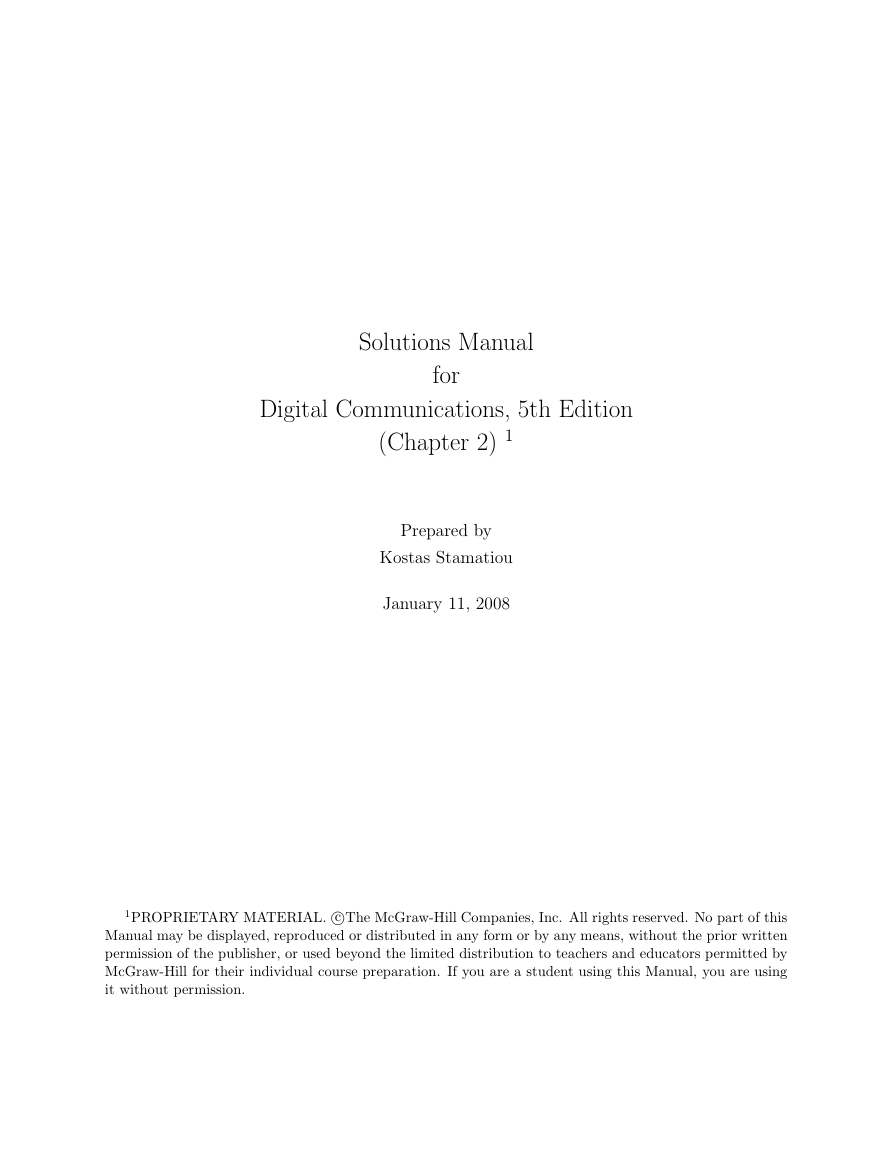
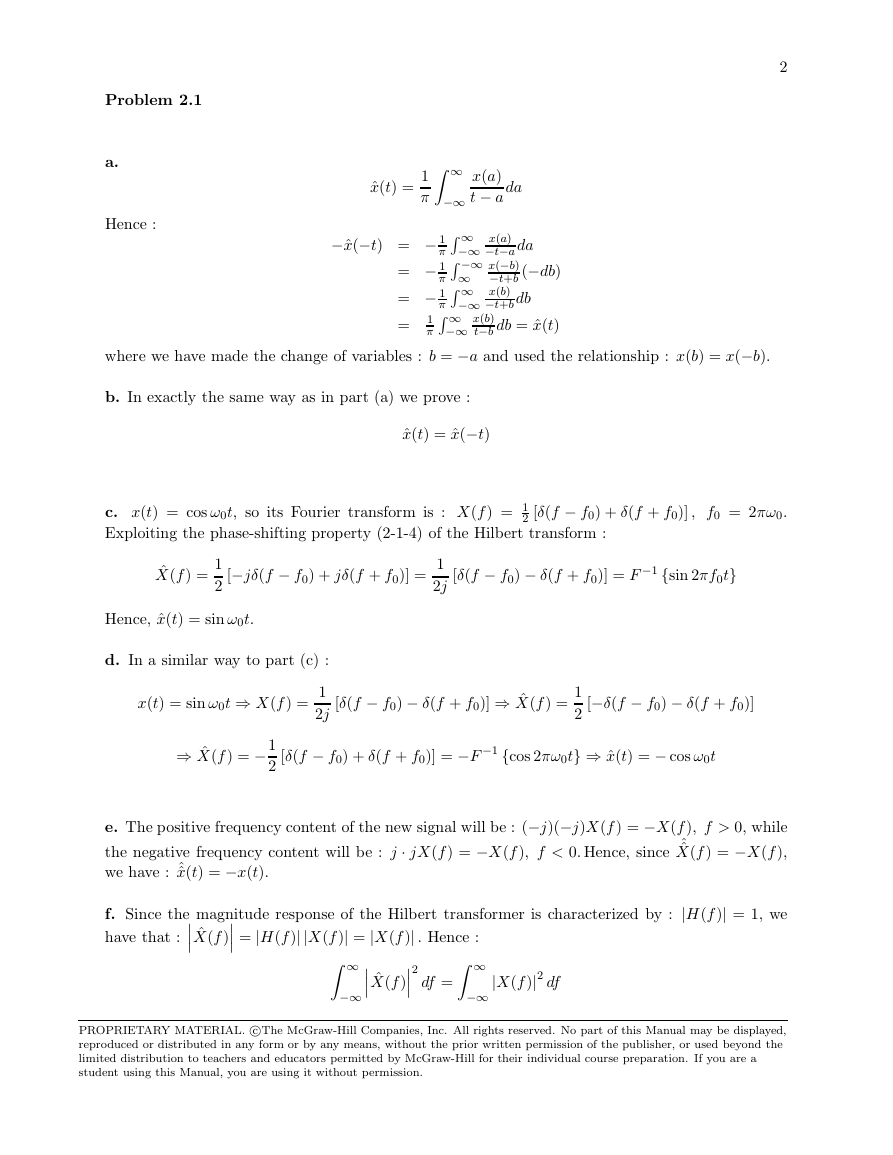
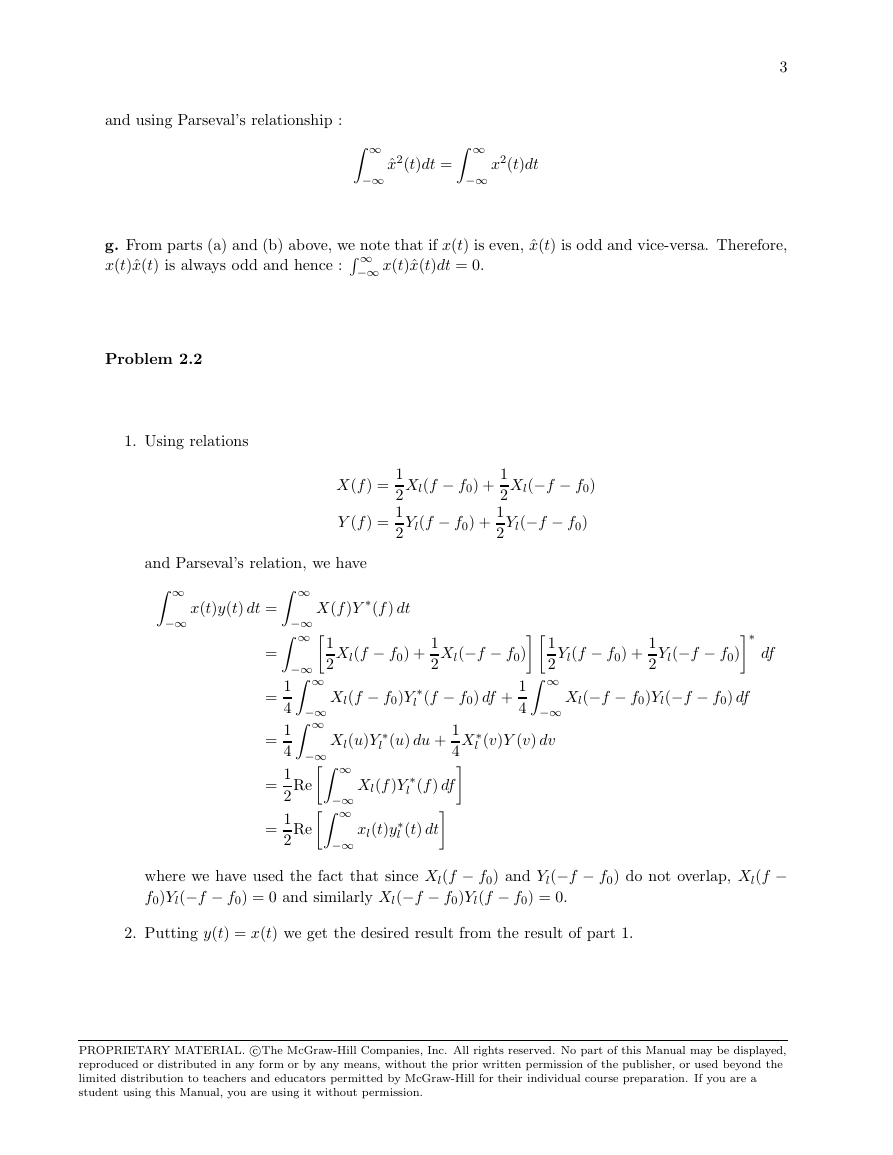
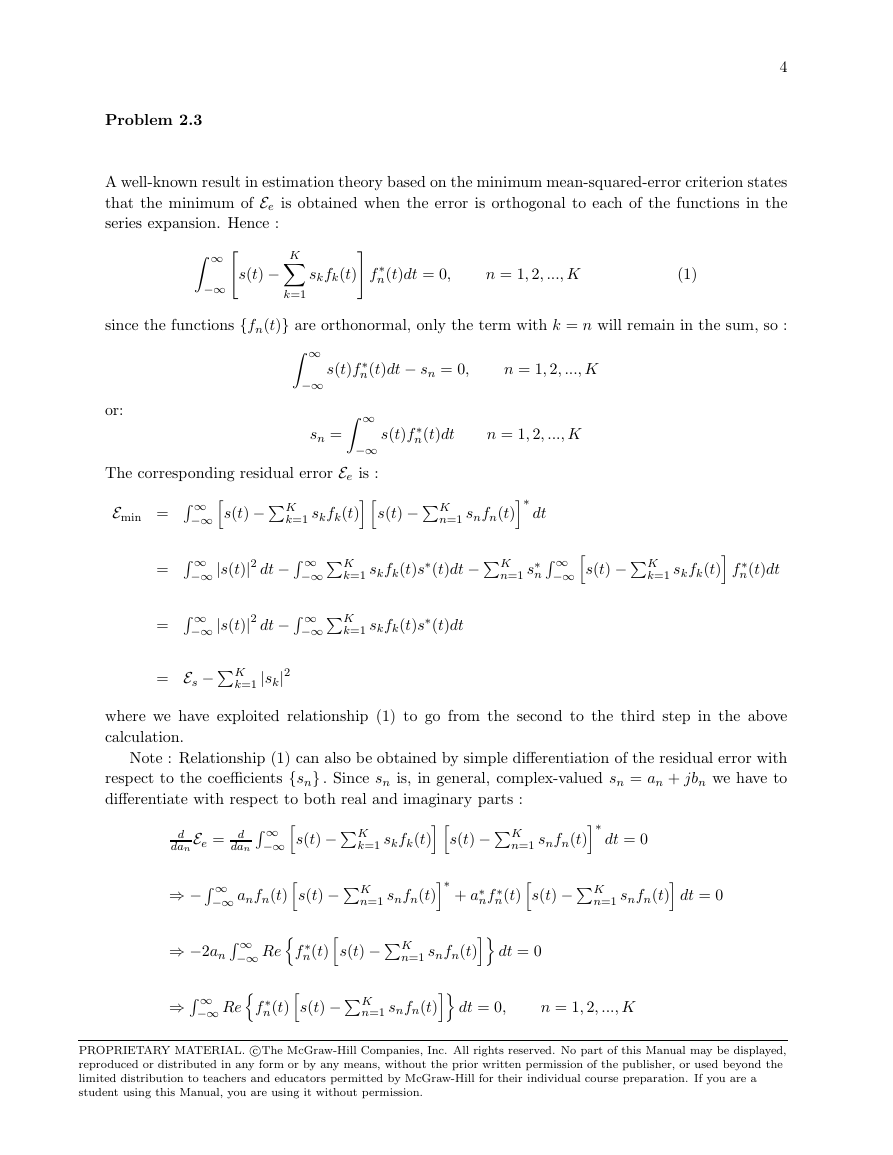
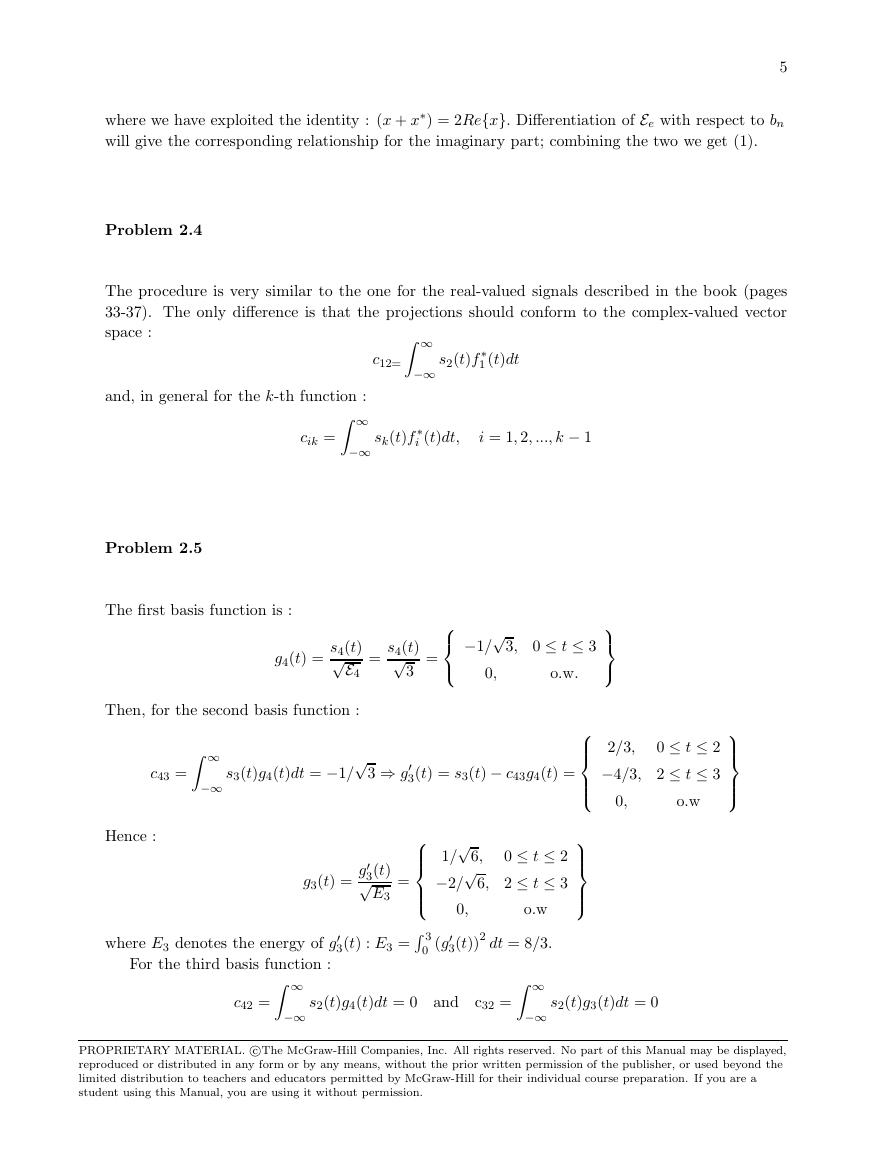
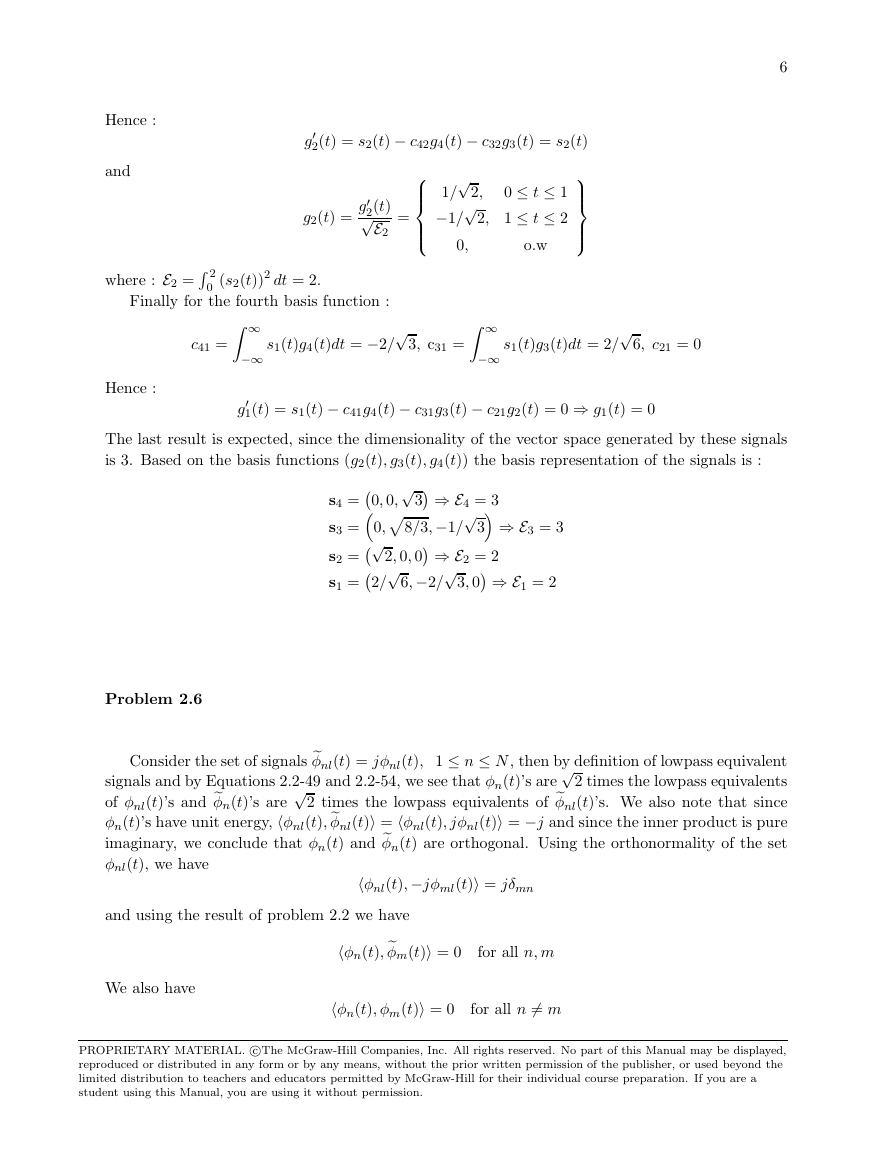
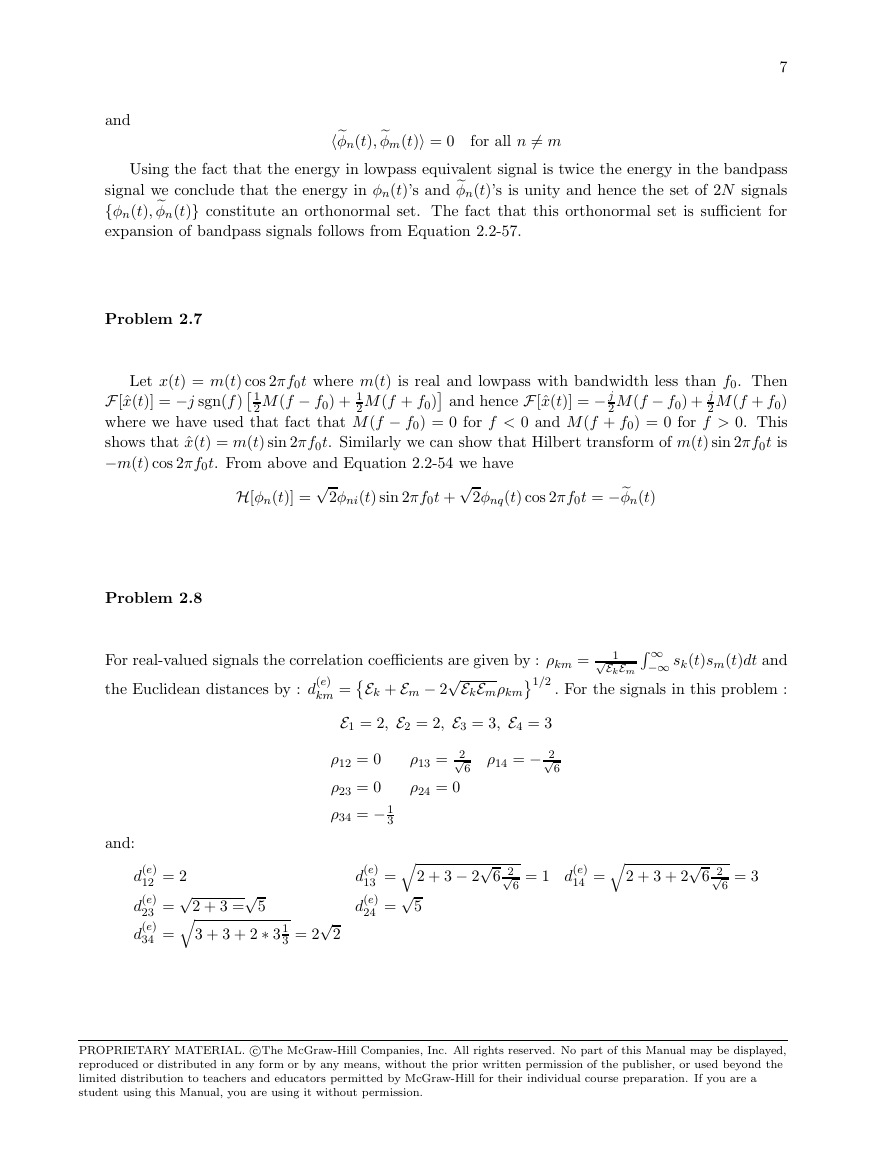
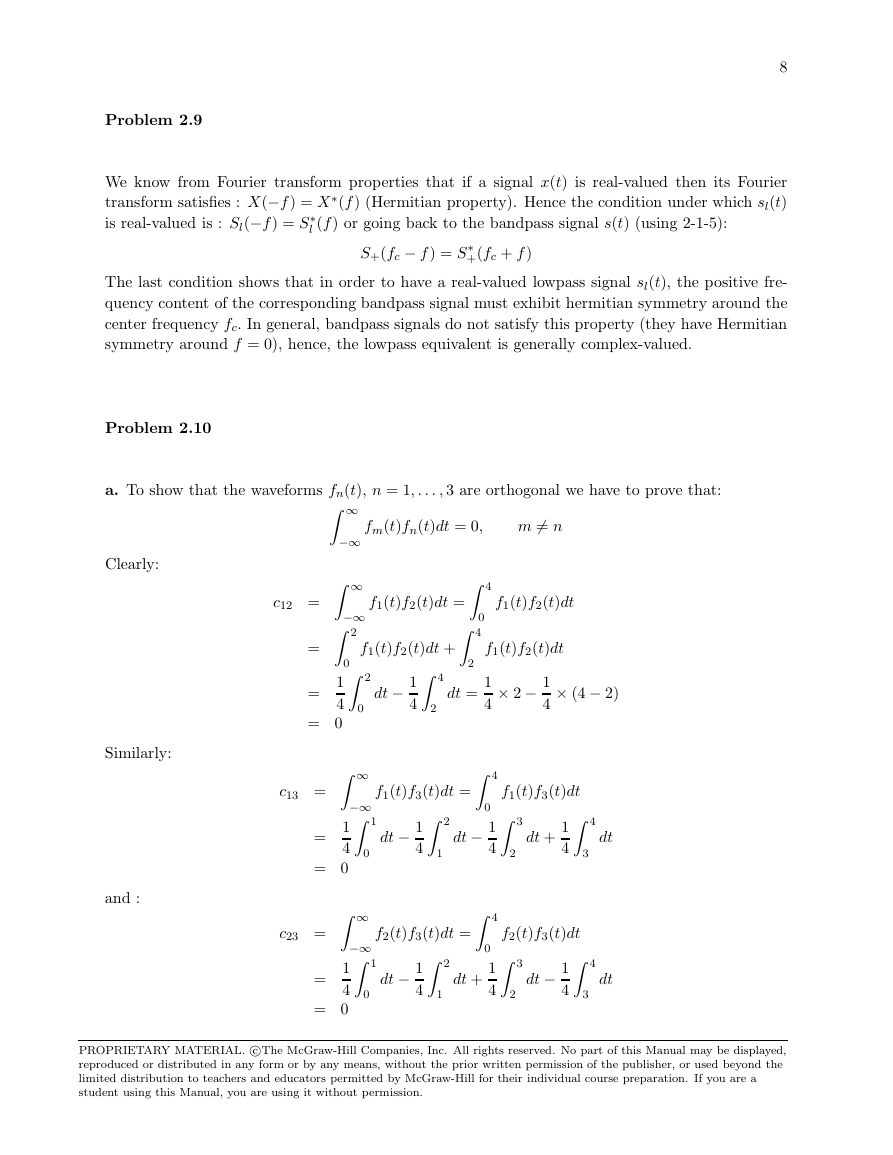








 2023年江西萍乡中考道德与法治真题及答案.doc
2023年江西萍乡中考道德与法治真题及答案.doc 2012年重庆南川中考生物真题及答案.doc
2012年重庆南川中考生物真题及答案.doc 2013年江西师范大学地理学综合及文艺理论基础考研真题.doc
2013年江西师范大学地理学综合及文艺理论基础考研真题.doc 2020年四川甘孜小升初语文真题及答案I卷.doc
2020年四川甘孜小升初语文真题及答案I卷.doc 2020年注册岩土工程师专业基础考试真题及答案.doc
2020年注册岩土工程师专业基础考试真题及答案.doc 2023-2024学年福建省厦门市九年级上学期数学月考试题及答案.doc
2023-2024学年福建省厦门市九年级上学期数学月考试题及答案.doc 2021-2022学年辽宁省沈阳市大东区九年级上学期语文期末试题及答案.doc
2021-2022学年辽宁省沈阳市大东区九年级上学期语文期末试题及答案.doc 2022-2023学年北京东城区初三第一学期物理期末试卷及答案.doc
2022-2023学年北京东城区初三第一学期物理期末试卷及答案.doc 2018上半年江西教师资格初中地理学科知识与教学能力真题及答案.doc
2018上半年江西教师资格初中地理学科知识与教学能力真题及答案.doc 2012年河北国家公务员申论考试真题及答案-省级.doc
2012年河北国家公务员申论考试真题及答案-省级.doc 2020-2021学年江苏省扬州市江都区邵樊片九年级上学期数学第一次质量检测试题及答案.doc
2020-2021学年江苏省扬州市江都区邵樊片九年级上学期数学第一次质量检测试题及答案.doc 2022下半年黑龙江教师资格证中学综合素质真题及答案.doc
2022下半年黑龙江教师资格证中学综合素质真题及答案.doc